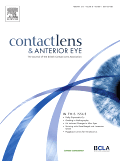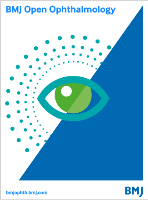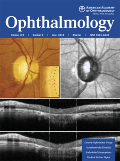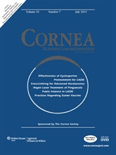
Contact Lens & Anterior Eye
Scope & Guideline
Exploring the Future of Anterior Eye Care
Introduction
Aims and Scopes
- Contact Lens Development and Design:
Research in this area covers innovative materials, technologies, and designs of contact lenses, including orthokeratology, scleral lenses, and multifocal contact lenses, aimed at improving comfort, efficacy, and patient outcomes. - Ocular Health and Disease Management:
The journal publishes studies on the relationship between contact lens wear and ocular health, focusing on conditions such as dry eye disease, keratoconus, and infections, along with their management strategies. - Myopia Control Strategies:
A significant focus is on various methods for managing myopia progression, particularly in children, through the use of orthokeratology and other specialized lenses. - Patient Compliance and Experience:
The journal explores patient behaviors and compliance with contact lens wear and care, analyzing factors affecting satisfaction and effectiveness of contact lens-related therapies. - Clinical Practices and Guidelines:
Research includes evaluations of clinical practices related to contact lens fitting, care, and management, with an emphasis on evidence-based approaches to enhance patient care.
Trending and Emerging
- Innovative Myopia Control Approaches:
Research on innovative methods for myopia control, particularly in children, is trending, with a focus on the efficacy of orthokeratology and new contact lens designs aimed at slowing progression. - Digital Eye Strain and Contact Lens Wear:
With the increase in screen time, studies addressing digital eye strain and its relationship with contact lens wear have gained prominence, reflecting a contemporary concern for eye health. - Artificial Intelligence in Contact Lens Management:
There is a growing trend in the application of artificial intelligence for optimizing contact lens fitting and management, indicating a shift towards more tech-integrated approaches in clinical practice. - Environmental Impact of Contact Lenses:
Emerging studies are focusing on the environmental implications of contact lens disposal and waste, reflecting a broader societal concern about sustainability in healthcare. - Personalized Contact Lens Solutions:
Research into personalized contact lens solutions based on individual patient needs and characteristics is increasing, showcasing a move towards tailored approaches in ocular care.
Declining or Waning
- Traditional Contact Lens Fitting Techniques:
There has been a noticeable decline in research focused solely on traditional fitting methods, as the field shifts towards more technologically advanced fitting techniques, including the use of artificial intelligence and imaging technologies. - General Dry Eye Studies:
While dry eye disease remains a critical area of research, publications specifically focused on general dry eye studies without a direct link to contact lens wear are becoming less frequent, as the emphasis moves towards more integrated approaches. - Basic Microbial Studies:
Research centered on basic microbial studies related to contact lens contamination is waning, with a growing focus on clinical implications and the effectiveness of new disinfection methods and solutions.
Similar Journals

BMJ Open Ophthalmology
Advancing Visionary Research in OphthalmologyBMJ Open Ophthalmology is an esteemed, open-access journal dedicated to the field of ophthalmology, published by the renowned BMJ Publishing Group. Established in 2016, this journal has quickly made its mark within the ophthalmology community, achieving a respectable Q2 ranking in the 2023 category quartiles. It is indexed in Scopus, boasting a commendable ranking of **#52** out of **137** in the medicine discipline of ophthalmology, placing it in the **62nd percentile**. This global platform is committed to disseminating high-quality research, clinical studies, and innovative practices that propel the understanding and treatment of eye diseases. With its open access model, BMJ Open Ophthalmology ensures that vital research is readily available to health professionals, researchers, and students, fostering collaboration and advancing knowledge within the field. The journal is based in London, United Kingdom, and continues to welcome submissions that explore the latest advancements in ophthalmic science, contributing to enhanced patient care and outcomes.

Spektrum der Augenheilkunde
Bridging Knowledge Gaps in OphthalmologyWelcome to Spektrum der Augenheilkunde, a distinguished journal published by SPRINGER WIEN, dedicated to the field of ophthalmology since its inception in 1987. With an ISSN of 0930-4282 and an E-ISSN of 1613-7523, this journal is recognized for its commitment to publishing original research, reviews, and clinical studies that address current and emerging topics in eye health and treatment. Although classified in the Q4 category for ophthalmology as per the latest 2023 rankings, it serves as a valuable platform for researchers, professionals, and students looking to contribute to and expand their knowledge in this vital area of medicine. Based in Austria and accessible through various academic databases, the journal aims to foster communication among professionals and advance the understanding of ocular diseases, innovative therapies, and clinical best practices.

Clinical Ophthalmology
Advancing eye health through innovative research.Clinical Ophthalmology is a leading Open Access journal published by Dove Medical Press Ltd, dedicated to advancing the field of ophthalmology through peer-reviewed research and clinical studies. With a strong impact factor and ranked in the Q1 category of ophthalmology as of 2023, this journal is recognized for its significant contribution to the body of knowledge pertaining to eye health, vision science, and clinical practice. Its Scopus ranking places it within the top 30% of journals in the field, reflecting its influence and relevance in both academic and clinical landscapes. Since its inception in 2007, Clinical Ophthalmology has established a reputation for fostering high-quality research, providing a platform for researchers, professionals, and students to share their findings and insights. The journal's commitment to open access ensures that groundbreaking research is freely available to the global community, supporting innovation and collaboration in the pursuit of better patient outcomes worldwide. For those engaged in ophthalmological research and clinical practice, Clinical Ophthalmology serves as an invaluable resource and a hub for the latest developments in the field.

EUROPEAN JOURNAL OF OPHTHALMOLOGY
Exploring the Frontiers of OphthalmologyThe EUROPEAN JOURNAL OF OPHTHALMOLOGY, published by SAGE PUBLICATIONS LTD, is a leading international journal in the field of ophthalmology, dedicated to advancing the understanding and treatment of ocular diseases and disorders. With an ISSN of 1120-6721 and an E-ISSN of 1724-6016, the journal aims to provide a platform for innovative research, critical reviews, and comprehensive studies that span the diverse aspects of the discipline. As part of its commitment to disseminating high-quality research, the journal is indexed in Scopus, achieving an impressive rank of #47 out of 137 in the Medicine - Ophthalmology category, indicating its strong impact within the academic community. With a current impact factor that places it in the Q2 quartile for both Medicine (miscellaneous) and Ophthalmology as of 2023, it offers researchers and practitioners access to important findings and developments in eye health. The journal's converged years from 1991 to 2024 exemplify its longstanding commitment to the field, making it an essential resource for anyone looking to stay at the forefront of ophthalmological research.

Ocular Surface
Pioneering Discoveries for Visionary CareOcular Surface, published by Elsevier, stands at the forefront of ophthalmology research, with a notable Impact Factor reflecting its significant contribution to the field. As a vibrant platform for disseminating cutting-edge findings, this journal has achieved Q1 ranking in the Ophthalmology category as of 2023, placing it amongst the top-tier journals globally, specifically ranking 4th out of 137 in Scopus with an impressive 97th percentile. Spanning across the years from 2003 to 2024, Ocular Surface focuses on advancing knowledge in areas such as ocular pathology, therapy, and surgical interventions. While the journal is not open access, it provides invaluable insights and empirical data essential for researchers, professionals, and students dedicated to improving ocular health. With an address rooted in Amsterdam, Netherlands, this esteemed journal continues to enrich the global conversation in ophthalmology.

OPHTHALMOLOGY
Exploring innovative treatments for complex ocular conditions.OPHTHALMOLOGY is a leading journal in the field of ocular health, widely recognized for its contributions to advancing the understanding and treatment of ophthalmic conditions. Published by ELSEVIER SCIENCE INC in the United States, it has earned a prestigious place within the academic community, boasting a remarkable Q1 ranking in the ophthalmology category for 2023, along with an impressive Scopus rank of #2 out of 137, placing it in the 98th percentile. With a strong publication history dating back to 1958, OPHTHALMOLOGY encompasses high-quality research articles, reviews, and clinical studies that address critical issues in the field. Researchers, professionals, and students alike can access its comprehensive research through traditional subscription options, fostering an ongoing dialogue among experts. Whether you are seeking the latest treatments, understanding complex ocular diseases, or looking to advance your knowledge, OPHTHALMOLOGY remains an essential resource for cutting-edge research and insights.

GRAEFES ARCHIVE FOR CLINICAL AND EXPERIMENTAL OPHTHALMOLOGY
Unveiling the Science Behind SightGRAEFES ARCHIVE FOR CLINICAL AND EXPERIMENTAL OPHTHALMOLOGY, published by Springer, has established itself as a premier journal in the field of ophthalmology since its inception in 1870. With an ISSN of 0721-832X and an E-ISSN of 1435-702X, this esteemed journal enjoys a notable impact in the research community, ranking Q1 in Ophthalmology and Q1 in Sensory Systems, as per the latest 2023 journal category quartiles. GRAEFES Archive is dedicated to advancing our understanding of ocular health through both clinical and experimental studies, making it an essential resource for researchers, practitioners, and students alike. Its comprehensive scope covers various aspects of ophthalmic science, reflecting its long-standing commitment to quality and excellence. Although it currently operates on a subscription basis, the journal's significant Scopus rankings—24th out of 137 in Ophthalmology—underscore its relevance and influence within the scientific community. Situated in Germany, with its address in the United States, this international journal continues to shape the discourse on vision science and therapeutic innovation.

CORNEA
Transforming knowledge into practice for ocular health.CORNEA is a prestigious peer-reviewed journal published by Lippincott Williams & Wilkins, focusing on the rapidly advancing field of ophthalmology with a particular emphasis on corneal research and diseases. With an impact factor categorized in the prestigious Q1 quartile for its discipline, CORNEA has established itself as a leading platform for the dissemination of both fundamental and clinical studies since its inception in 1982. The journal is ranked 25th out of 137 in the Scopus Medicine-Ophthalmology category, placing it in the 82nd percentile among its peers, which underscores its vital role in influencing ocular research and clinical practices. While the journal is not currently open access, it provides valuable insights and updates for professionals, researchers, and students working to advance knowledge in corneal health, contributing significantly to the ongoing dialogue in the ophthalmological community. With a commitment to excellence, CORNEA continues to publish high-quality research and reviews in its pursuit to improve ocular outcomes and patient care.

Augenheilkunde Up2date
Transforming Research into Practice in Ophthalmology.Augenheilkunde Up2date is a pivotal journal in the field of ophthalmology, published by GEORG THIEME VERLAG KG, a renowned publisher known for its commitment to advancing medical knowledge. With its ISSN 1616-9719 and E-ISSN 1616-9735, this journal serves as a vital resource for researchers, professionals, and students interested in the latest developments and nuanced discussions in eye health. Although not available as open access, its curated content offers significant insights into contemporary research, clinical practices, and emerging trends in ophthalmology, thus promoting the continuous professional development of its readers. There is an emphasis on providing comprehensive reviews that encapsulate the pertinent advancements in the field, making it an essential publication for those aiming to enhance their expertise in eye care and vision science.

Eye and Vision
Connecting global minds in the pursuit of vision advancements.Eye and Vision, published by BMC, is a leading open-access journal dedicated to the dynamic field of ophthalmology and visual sciences. With its ISSN 2326-0246 and E-ISSN 2326-0254, the journal has established itself as a premier platform for innovative research and clinical studies, achieving impressive rankings in 2023 as Q1 in both Health Professions (Miscellaneous) and Ophthalmology categories. The journal's commitment to accessible knowledge since its transition to open access in 2015 enhances its global reach, allowing researchers, clinicians, and students to share and access top-tier studies and advancements in the field. Located in the United Kingdom and delivering influential insights from 2014 through to 2024, Eye and Vision holds significant relevance, with a Scopus ranking placing it in the 99th percentile for Health Professions and the 93rd percentile for Ophthalmology, making it an essential resource for those looking to stay at the forefront of eye research and vision science.